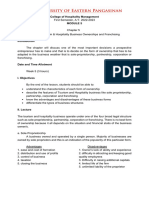0% found this document useful (0 votes)
22 views20 pagesForms of Bus
The document outlines various forms of business organization including sole proprietorship, joint Hindu family business, partnership, co-operative society, and joint stock company, detailing their merits and limitations. It emphasizes the characteristics of each type, such as liability, decision-making, and capital contribution. Additionally, it discusses the types of partners in partnerships and the classification of companies based on ownership and duration.
Uploaded by
mrplomplimCopyright
© © All Rights Reserved
We take content rights seriously. If you suspect this is your content, claim it here.
Available Formats
Download as PDF, TXT or read online on Scribd
0% found this document useful (0 votes)
22 views20 pagesForms of Bus
The document outlines various forms of business organization including sole proprietorship, joint Hindu family business, partnership, co-operative society, and joint stock company, detailing their merits and limitations. It emphasizes the characteristics of each type, such as liability, decision-making, and capital contribution. Additionally, it discusses the types of partners in partnerships and the classification of companies based on ownership and duration.
Uploaded by
mrplomplimCopyright
© © All Rights Reserved
We take content rights seriously. If you suspect this is your content, claim it here.
Available Formats
Download as PDF, TXT or read online on Scribd
/ 20






















































































